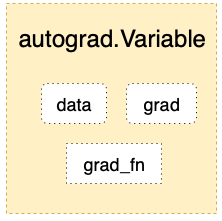PyTorch的简洁设计使得它入门很简单,在深入介绍PyTorch之前,本节将先介绍一些PyTorch的基础知识,使得读者能够对PyTorch有一个大致的了解,并能够用PyTorch搭建一个简单的神经网络。
Tensor是PyTorch中重要的数据结构,可认为是一个高维数组。它可以是一个数(标量)、一维数组(向量)、二维数组(矩阵)以及更高维的数组。Tensor和Numpy的ndarrays类似,但Tensor可以使用GPU进行加速。Tensor的使用和Numpy及Matlab的接口十分相似。(与Tensorflow中的Tensorflow基本相同)
x = t.Tensor(5 , 3 ) [output]: 1.00000e-07 * 0.0000 0.0000 5.3571 0.0000 0.0000 0.0000 0.0000 0.0000 0.0000 0.0000 5.4822 0.0000 5.4823 0.0000 5.4823 [torch.FloatTensor of size 5x3]
x = t.rand(5 , 3 ) [output]: 0.3673 0.2522 0.3553 0.0070 0.7138 0.0463 0.6198 0.6019 0.3752 0.4755 0.3675 0.3032 0.5824 0.5104 0.5759 [torch.FloatTensor of size 5x3]
查看x的形状(torch.Size 是tuple对象的子类,因此它支持tuple的所有操作,如x.size()[0])
x = t.rand(5 , 3 ) y = t.rand(5 , 3 ) x + y t.add(x, y) result = t.Tensor(5 , 3 ) t.add(x, y, out=result) y.add(x) print(y) y.add_(x) print(y)
注意:函数名后面带下划线_ 的函数会修改Tensor本身。例如,x.add_(y)和x.t_()会改变 x,但x.add(y)和x.t()返回一个新的Tensor, 而x不变。
Tensor的选取操作与Numpy类似。Tensor和Numpy的数组之间的互操作非常容易且快速。对于Tensor不支持的操作,可以先转为Numpy数组处理,之后再转回Tensor
x[:, 1 ] a = t.ones(5 ) b = a.numpy() a = np.ones(5 ) b = t.from_numpy(a)
Tensor和numpy对象共享内存,所以他们之间的转换很快,而且几乎不会消耗什么资源。但这也意味着,如果其中一个变了,另外一个也会随之改变
Tensor可通过.cuda 方法转为GPU的Tensor,从而享受GPU带来的加速运算。
if t.cuda.is_available(): x = x.cuda() y = y.cuda() x + y
深度学习的算法本质上是通过反向传播求导数,而PyTorch的Autograd模块 则实现了此功能。在Tensor上的所有操作,Autograd都能为它们自动提供微分,避免了手动计算导数的复杂过程。
autograd.Variable 是Autograd中的核心类,它简单封装了Tensor,并支持几乎所有Tensor有的操作。Tensor在被封装为Variable之后,可以调用它的.backward实现反向传播,自动计算所有梯度。Variable的数据结构如图所示。
from torch.autograd import Variablex = Variable(t.ones(2 , 2 ), requires_grad = True ) x output: Variable containing: 1 1 1 1 [torch.FloatTensor of size 2x2] y = x.sum () y output: Variable containing: 4 [torch.FloatTensor of size 1 ]
y.grad_fn <SumBackward0 at 0x7fc14824b860 > y.backward() x.grad Variable containing: 1 1 1 1 [torch.FloatTensor of size 2x2]
注意:grad在反向传播过程中是累加的(accumulated),这意味着每一次运行反向传播,梯度都会累加之前的梯度,所以反向传播之前需把梯度清零。
y.backward() x.grad output: Variable containing: 2 2 2 2 [torch.FloatTensor of size 2x2] y.backward() x.grad output: Variable containing: 3 3 3 3 [torch.FloatTensor of size 2x2] x.grad.data.zero_() output: 0 0 0 0 [torch.FloatTensor of size 2x2] y.backward() x.grad output: Variable containing: 1 1 1 1 [torch.FloatTensor of size 2x2]
Variable和Tensor具有近乎一致的接口,在实际使用中可以无缝切换。
x = Variable(t.ones(4 ,5 )) y = t.cos(x) x_tensor_cos = t.cos(x.data) print(y) x_tensor_cos output: Variable containing: 0.5403 0.5403 0.5403 0.5403 0.5403 0.5403 0.5403 0.5403 0.5403 0.5403 0.5403 0.5403 0.5403 0.5403 0.5403 0.5403 0.5403 0.5403 0.5403 0.5403 [torch.FloatTensor of size 4x5] Out[25 ]: 0.5403 0.5403 0.5403 0.5403 0.5403 0.5403 0.5403 0.5403 0.5403 0.5403 0.5403 0.5403 0.5403 0.5403 0.5403 0.5403 0.5403 0.5403 0.5403 0.5403 [torch.FloatTensor of size 4x5]
Autograd实现了反向传播功能,但是直接用来写深度学习的代码在很多情况下还是稍显复杂,torch.nn是专门为神经网络设计的模块化接口。nn构建于 Autograd之上,可用来定义和运行神经网络。nn.Module是nn中最重要的类,可把它看成是一个网络的封装,包含网络各层定义以及forward方法,调用forward(input)方法,可返回前向传播的结果。下面就以最早的卷积神经网络:LeNet为例,来看看如何用nn.Module实现。LeNet的网络结构如图所示
定义网络时,需要继承nn.Module,并实现它的forward方法,把网络中具有可学习参数的层放在构造函数__init__中。如果某一层(如ReLU)不具有可学习的参数,则既可以放在构造函数中,也可以不放,但建议不放在其中,而在forward中使用nn.functional代替。
import torch.nn as nnimport torch.nn.functional as Fclass Net (nn.Module ): def __init__ (self ): super (Net, self).__init__() self.conv1 = nn.Conv2d(1 , 6 , 5 ) self.conv2 = nn.Conv2d(6 , 16 , 5 ) self.fc1 = nn.Linear(16 *5 *5 , 120 ) self.fc2 = nn.Linear(120 , 84 ) self.fc3 = nn.Linear(84 , 10 ) def forward (self, x ): x = F.max_pool2d(F.relu(self.conv1(x)), (2 , 2 )) x = F.max_pool2d(F.relu(self.conv2(x)), 2 ) x = x.view(x.size()[0 ], -1 ) x = F.relu(self.fc1(x)) x = F.relu(self.fc2(x)) x = self.fc3(x) return x net = Net() print(net)
output: Net( (conv1): Conv2d (1 , 6 , kernel_size=(5 , 5 ), stride=(1 , 1 )) (conv2): Conv2d (6 , 16 , kernel_size=(5 , 5 ), stride=(1 , 1 )) (fc1): Linear(in_features=400 , out_features=120 ) (fc2): Linear(in_features=120 , out_features=84 ) (fc3): Linear(in_features=84 , out_features=10 ) )
只要在nn.Module的子类中定义了forward函数,backward函数就会自动被实现(利用Autograd)。在forward 函数中可使用任何Variable支持的函数,还可以使用if、for循环、print、log等Python语法,写法和标准的Python写法一致。
网络的可学习参数通过net.parameters()返回,net.named_parameters可同时返回可学习的参数及名称。
params = list (net.parameters()) print(len (params)) for name,parameters in net.named_parameters(): print(name,':' ,parameters.size())
output: 10 conv1.weight : torch.Size([6 , 1 , 5 , 5 ]) conv1.bias : torch.Size([6 ]) conv2.weight : torch.Size([16 , 6 , 5 , 5 ]) conv2.bias : torch.Size([16 ]) fc1.weight : torch.Size([120 , 400 ]) fc1.bias : torch.Size([120 ]) fc2.weight : torch.Size([84 , 120 ]) fc2.bias : torch.Size([84 ]) fc3.weight : torch.Size([10 , 84 ]) fc3.bias : torch.Size([10 ])
forward函数的输入和输出都是Variable,只有Variable才具有自动求导功能,而Tensor是没有的,所以在输入时,需把Tensor封装成Variable。
input = Variable(t.randn(1 , 1 , 32 , 32 ).float ())out = net(input ) out.size()
output: torch.Size([1 , 10 ])
net.zero_grad() out.backward(Variable(t.ones(1 ,10 )))
nn实现了神经网络中大多数的损失函数,例如nn.MSELoss用来计算均方误差,nn.CrossEntropyLoss用来计算交叉熵损失
output = net(input ) target = Variable(t.arange(0 ,10 ).float ()) criterion = nn.MSELoss() loss = criterion(output, target) loss
output: Variable containing: 28.5536 [torch.FloatTensor of size 1 ]
当调用loss.backward()时,该图会动态生成并自动微分,也即会自动计算图中参数(Parameter)的导数。
net.zero_grad() print('反向传播之前 conv1.bias的梯度' ) print(net.conv1.bias.grad) loss.backward() print('反向传播之后 conv1.bias的梯度' ) print(net.conv1.bias.grad)
在反向传播计算完所有参数的梯度后,还需要使用优化方法来更新网络的权重和参数,例如随机梯度下降法(SGD)的更新策略如下:
weight = weight - learning_rate * gradient
learning_rate = 0.01 for f in net.parameters(): f.data.sub_(f.grad.data * learning_rate)
torch.optim中实现了深度学习中绝大多数的优化方法,例如RMSProp、Adam、SGD等,更便于使用,因此大多数时候并不需要手动写上述代码
import torch.optim as optimoptimizer = optim.SGD(net.parameters(), lr = 0.01 ) optimizer.zero_grad() output = net(input ) loss = criterion(output, target) loss.backward() optimizer.step()
在深度学习中数据加载及预处理是非常复杂繁琐的,但PyTorch提供了一些可极大简化和加快数据处理流程的工具。同时,对于常用的数据集,PyTorch也提供了封装好的接口供用户快速调用,这些数据集主要保存在torchvison中。
使用torchvision加载并预处理CIFAR-10数据集
定义网络
定义损失函数和优化器
训练网络并更新网络参数
测试网络
transform = transforms.Compose([ transforms.ToTensor(), transforms.Normalize((0.5 , 0.5 , 0.5 ), (0.5 , 0.5 , 0.5 )), ]) trainset = tv.datasets.CIFAR10( root='/Users/lichao/学习资料/研究生阶段/PYTORCH_LEARNING/dataset' , train=True , download=True , transform=transform) trainloader = t.utils.data.DataLoader( trainset, batch_size=4 , shuffle=True , num_workers=2 ) testset = tv.datasets.CIFAR10( '/Users/lichao/学习资料/研究生阶段/PYTORCH_LEARNING/dataset' , train=False , download=True , transform=transform) testloader = t.utils.data.DataLoader( testset, batch_size=4 , shuffle=False , num_workers=2 ) classes = ('plane' , 'car' , 'bird' , 'cat' , 'deer' , 'dog' , 'frog' , 'horse' , 'ship' , 'truck' )
Dataset对象是一个数据集,可以按下标访问,返回形如(data, label)的数据。
(data, label) = trainset[500 ] print(classes[label]) show((data + 1 ) / 2 ).resize((100 , 100 ))
Dataloader是一个可迭代的对象,它将dataset返回的每一条数据拼接成一个batch,并提供多线程加速优化和数据打乱等操作。当程序对dataset的所有数据遍历完一遍之后,相应的对Dataloader也完成了一次迭代。
dataiter = iter (trainloader) images, labels = dataiter.next () print(' ' .join('%11s' %classes[labels[j]] for j in range (4 ))) show(tv.utils.make_grid((images+1 )/2 )).resize((400 ,100 ))
import torch.nn as nnimport torch.nn.functional as Fclass Net (nn.Module ): def __init__ (self ): super (Net, self).__init__() self.conv1 = nn.Conv2d(3 , 6 , 5 ) self.conv2 = nn.Conv2d(6 , 16 , 5 ) self.fc1 = nn.Linear(16 *5 *5 , 120 ) self.fc2 = nn.Linear(120 , 84 ) self.fc3 = nn.Linear(84 , 10 ) def forward (self, x ): x = F.max_pool2d(F.relu(self.conv1(x)), (2 , 2 )) x = F.max_pool2d(F.relu(self.conv2(x)), 2 ) x = x.view(x.size()[0 ], -1 ) x = F.relu(self.fc1(x)) x = F.relu(self.fc2(x)) x = self.fc3(x) return x net = Net() print(net)
from torch import optimcriterion = nn.CrossEntropyLoss() optimizer = optim.SGD(net.parameters(), lr=0.001 , momentum=0.9 )
t.set_num_threads(8 ) for epoch in range (2 ): running_loss = 0.0 for i, data in enumerate (trainloader, 0 ): inputs, labels = data inputs, labels = Variable(inputs), Variable(labels) optimizer.zero_grad() outputs = net(inputs) loss = criterion(outputs, labels) loss.backward() optimizer.step() running_loss += loss.item() if i % 2000 == 1999 : print('[%d, %5d] loss: %.3f' \ % (epoch+1 , i+1 , running_loss / 2000 )) running_loss = 0.0 print('Finished Training' )
此处仅训练了2个epoch(遍历完一遍数据集称为一个epoch),来看看网络有没有效果。将测试图片输入到网络中,计算它的label,然后与实际的label进行比较。
dataiter = iter (testloader) images, labels = dataiter.next () print('实际的label: ' , ' ' .join(\ '%08s' %classes[labels[j]] for j in range (4 ))) show(tv.utils.make_grid(images / 2 - 0.5 )).resize((400 ,100 ))
outputs = net(Variable(images)) _, predicted = t.max (outputs.data, 1 ) print('预测结果: ' , ' ' .join('%5s' \ % classes[predicted[j]] for j in range (4 )))
correct = 0 total = 0 for data in testloader: images, labels = data outputs = net(Variable(images)) _, predicted = t.max (outputs.data, 1 ) total += labels.size(0 ) correct += (predicted == labels).sum () print('10000张测试集中的准确率为: %d %%' % (100 * correct / total))
就像之前把Tensor从CPU转到GPU一样,模型也可以类似地从CPU转到GPU。
if t.cuda.is_available(): net.cuda() images = images.cuda() labels = labels.cuda() output = net(Variable(images)) loss= criterion(output,Variable(labels))
如果发现在GPU上并没有比CPU提速很多,实际上是因为网络比较小,GPU没有完全发挥自己的真正实力。













